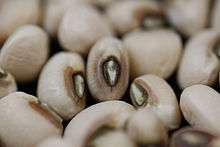Definify.com
Webster 1913 Edition
Hilum
Hi′lum
,Noun.
[L., a little thing, trifle.]
1.
(Bot.)
The eye of a bean or other seed; the mark or scar at the point of attachment of an ovule or seed to its base or support; – called also
hile
. 2.
(Anat.)
The part of a gland, or similar organ, where the blood vessels and nerves enter; the hilus;
as, the
. hilum
of the kidneyWebster 1828 Edition
Hilum
HI'LUM
,Noun.
Definition 2025
hilum
hilum
English

The hila (sense 1) of black-eyed peas
Alternative forms
Noun
hilum (plural hila)
- (botany) The eye of a bean or other seed; the mark or scar at the point of attachment of an ovule or seed to its base or support.
- 2005, David Feldman, Do Elephants Jump? (Imponderables Book), New York, N.Y.: HarperCollins Publishers, ISBN 978-0-06-053913-9, page 24:
- On the tip of each corn kernel is a hilum, collectively known as the "black layer," where it is attached to the cob. While corn is growing, nutrients are being transferred from the rest of the cob to the kernels through the hilum.
- (botany) The nucleus of a starch grain.
- 1916, William Mansfield, Histology of Medicinal Plants, New York, N.Y.: John Wiley & Sons, OCLC 1164403, page 188:
- In central hilum starch grains the grain is laid down around the hilum in the form of concentric layers.
-
- (anatomy) A depression or fissure through which ducts, nerves, or blood vessels enter and leave a gland or organ; a porta.
- 1998, R[obert] M[atthew] H[ay] McMinn; R. T. Hutchings; B. M. Logan, “Abdomen”, in The Concise Handbook of Human Anatomy, London: Manson Publishing, ISBN 978-1-874545-52-1, pages 144–145:
- [The pancreas] is a hook-shaped gland, about 15 cm long, that lies transversely across the upper abdomen, with the head in the C-shaped curve of the duodenum […], extending to the left as the body behind the stomach and ending as the tail lying against the hilum of the spleen.
- 2010, Benoît Ghaye, “Imaging of Hila and Pulmonary Vessels”, in Emmanuel E. Coche, Benoît Ghaye, Johan De Mey, and Philippe Duyck, editors, Comparative Interpretation of CT and Standard Radiography of the Chest, Heidelberg: Springer, DOI:, ISBN 978-3-540-79941-2, page 166:
- The shadows of the hila on chest X-ray are mainly formed by the pulmonary arteries (PAs) and some of their main branches and the upper pulmonary veins (PVs).
- 2010, W. Richard Webb; Charles B. Higgins, Thoracic Imaging: Pulmonary and Cardiovascular Radiology, 2nd edition, Philadelphia, Pa.; London: Lippincott Williams & Wilkins, ISBN 978-1-60547-976-7, page 161:
- In the large majority of normal patients, the hila appear equal in size on frontal radiographs; comparison of the two hila is helpful in patients with a unilateral abnormality.
-
Synonyms
- (fissure): porta
Related terms
Translations
(botany) eye of a seed
(anatomy) porta of an organ
Latin
Etymology
Unknown.[1], possibly Semitic source.
Pronunciation
- (Classical) IPA(key): /ˈhiː.lum/, [ˈhiː.ɫũ]
Noun
hīlum n (genitive hīlī); second declension
- trifle
- (in the negative) not a whit, not in the least
Inflection
Second declension.
| Case | Singular | Plural |
|---|---|---|
| nominative | hīlum | hīla |
| genitive | hīlī | hīlōrum |
| dative | hīlō | hīlīs |
| accusative | hīlum | hīla |
| ablative | hīlō | hīlīs |
| vocative | hīlum | hīla |
Descendants
References
- hilum in Charlton T. Lewis and Charles Short (1879) A Latin Dictionary, Oxford: Clarendon Press
- hilum in Charlton T. Lewis (1891) An Elementary Latin Dictionary, New York: Harper & Brothers
- HILUM in Charles du Fresne du Cange’s Glossarium Mediæ et Infimæ Latinitatis (augmented edition, 1883–1887)
- Félix Gaffiot (1934), “hilum”, in Dictionnaire Illustré Latin-Français, Paris: Hachette.
- hilum in Ramminger, Johann (accessed 16 July 2016) Neulateinische Wortliste: Ein Wörterbuch des Lateinischen von Petrarca bis 1700, pre-publication website, 2005-2016
- ↑ De Vaan, Michiel (2008) Etymological Dictionary of Latin and the other Italic Languages (Leiden Indo-European Etymological Dictionary Series; 7), Leiden, Boston: Brill